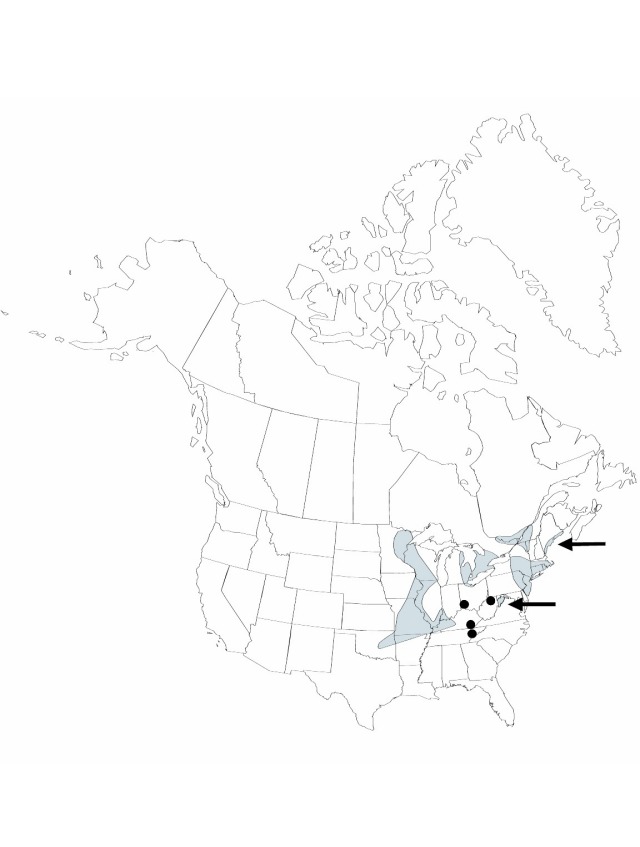Difference between revisions of "Sparganium androcladum"
Bulletin of the Torrey Botanical Club 15: 78. 1888.
FNA>Volume Importer |
imported>Volume Importer |
||
| (6 intermediate revisions by 2 users not shown) | |||
| Line 8: | Line 8: | ||
}} | }} | ||
|common_names=Rubanier rameux | |common_names=Rubanier rameux | ||
| − | |basionyms={{Treatment/ID/ | + | |special_status={{Treatment/ID/Special_status |
| + | |code=E | ||
| + | |label=Endemic | ||
| + | }} | ||
| + | |basionyms={{Treatment/ID/Basionym | ||
|name=Sparganium simplex var. androcladum | |name=Sparganium simplex var. androcladum | ||
|authority=Engelmann | |authority=Engelmann | ||
| + | |rank=variety | ||
| + | |publication_title=in A. Gray, Man. Bot. Northern U.S., Manual, ed. | ||
| + | |publication_place=5, 481. 1867 | ||
}} | }} | ||
|synonyms={{Treatment/ID/Synonym | |synonyms={{Treatment/ID/Synonym | ||
|name=Sparganium americanum var. androcladum | |name=Sparganium americanum var. androcladum | ||
|authority=(Engelmann) Fernald & Eames | |authority=(Engelmann) Fernald & Eames | ||
| + | |rank=variety | ||
}} | }} | ||
|hierarchy=Sparganiaceae;Sparganium;Sparganium androcladum | |hierarchy=Sparganiaceae;Sparganium;Sparganium androcladum | ||
| Line 30: | Line 38: | ||
|elevation=0–800 m | |elevation=0–800 m | ||
|distribution=Ont.;Que.;Ark.;Conn.;Ill.;Ind.;Iowa;Ky.;Maine;Mass.;Mich.;Minn.;Mo.;N.H.;N.J.;N.Y.;Ohio;Okla.;Pa.;R.I.;Tenn.;Vt.;W.Va.;Wis. | |distribution=Ont.;Que.;Ark.;Conn.;Ill.;Ind.;Iowa;Ky.;Maine;Mass.;Mich.;Minn.;Mo.;N.H.;N.J.;N.Y.;Ohio;Okla.;Pa.;R.I.;Tenn.;Vt.;W.Va.;Wis. | ||
| − | |discussion=<p>Sparganium androcladum is less variable than the similar and more common S. americanum, from which it is distinguished by its generally larger size and more robust habit; leaves stiffer, wider, more strongly keeled; inflorescence branches usually without pistillate heads, the bracts ascending; fruiting heads larger; fruits distally shiny, the beak longer and hooked. Immature fruits of S. androcladum resemble mature fruits of S. americanum. Some specimens will not key readily to either species. The complex nomenclatural history is discussed by C. D. K. Cook and M. S. Nicholls (1987).</p><!-- | + | |discussion=<p><i>Sparganium androcladum</i> is less variable than the similar and more common <i>S. americanum</i>, from which it is distinguished by its generally larger size and more robust habit; leaves stiffer, wider, more strongly keeled; inflorescence branches usually without pistillate heads, the bracts ascending; fruiting heads larger; fruits distally shiny, the beak longer and hooked. Immature fruits of <i>S. androcladum</i> resemble mature fruits of <i>S. americanum</i>. Some specimens will not key readily to either species. The complex nomenclatural history is discussed by C. D. K. Cook and M. S. Nicholls (1987).</p><!-- |
| − | --><p>Sparganium androcladum has an unusual, discontinuous distribution, which is wholly within the range of S. americanum, except in the central Mississippi Valley (M. L. Fernald 1922b). In the absence of convincing specimens, the presence of S. androcladum in Virginia cannot be confirmed, although E. O. Beal (1960) reported it there, and it occurs nearby in West Virginia.</p> | + | --><p><i>Sparganium androcladum</i> has an unusual, discontinuous distribution, which is wholly within the range of <i>S. americanum</i>, except in the central Mississippi Valley (M. L. Fernald 1922b). In the absence of convincing specimens, the presence of <i>S. androcladum</i> in Virginia cannot be confirmed, although E. O. Beal (1960) reported it there, and it occurs nearby in West Virginia.</p> |
|tables= | |tables= | ||
|references= | |references= | ||
| Line 40: | Line 48: | ||
-->{{#Taxon: | -->{{#Taxon: | ||
name=Sparganium androcladum | name=Sparganium androcladum | ||
| − | |||
|authority=(Engelmann) Morong | |authority=(Engelmann) Morong | ||
|rank=species | |rank=species | ||
| Line 54: | Line 61: | ||
|publication title=Bulletin of the Torrey Botanical Club | |publication title=Bulletin of the Torrey Botanical Club | ||
|publication year=1888 | |publication year=1888 | ||
| − | |special status= | + | |special status=Endemic |
| − | |source xml=https:// | + | |source xml=https://bitbucket.org/aafc-mbb/fna-data-curation/src/2e0870ddd59836b60bcf96646a41e87ea5a5943a/coarse_grained_fna_xml/V22/V22_26.xml |
|genus=Sparganium | |genus=Sparganium | ||
|species=Sparganium androcladum | |species=Sparganium androcladum | ||
Latest revision as of 20:30, 5 November 2020
Plants robust, to 1.2 m; leaves and inflorescences erect, emergent. Leaves stiff, keeled from base at least to middle, flattened distally, to 1.2 m × 5–15 mm. Inflorescences: rachis (0–)1–3 branched, erect, bracts strongly ascending, not basally inflated; pistillate heads (1–)2–4 on main rachis, 0(–2) on lateral branches, axillary, not contiguous, sessile or short-peduncled, 2.5–3.5 cm diam. in fruit; staminate heads 3–8 on main rachis, 1–6 on lateral rachises, most not contiguous. Flowers: tepals often with prominent subapical dark spot, subentire to entire; stigma 1, linear. Fruits brown, proximally dull, distally shiny, subsessile to short-stipitate, fusiform, usually constricted near equator, body not strongly faceted, 5–7 × 2.5–3 mm, tapering to beak; beak often curved and hooked, 4–7 mm; tepals attached at base, reaching to equator or somewhat beyond. Seeds 1.
Phenology: Flowering late spring–summer (Apr–Jul).
Habitat: Shores and shallow, quiet, circumneutral waters
Elevation: 0–800 m
Distribution

Ont., Que., Ark., Conn., Ill., Ind., Iowa, Ky., Maine, Mass., Mich., Minn., Mo., N.H., N.J., N.Y., Ohio, Okla., Pa., R.I., Tenn., Vt., W.Va., Wis.
Discussion
Sparganium androcladum is less variable than the similar and more common S. americanum, from which it is distinguished by its generally larger size and more robust habit; leaves stiffer, wider, more strongly keeled; inflorescence branches usually without pistillate heads, the bracts ascending; fruiting heads larger; fruits distally shiny, the beak longer and hooked. Immature fruits of S. androcladum resemble mature fruits of S. americanum. Some specimens will not key readily to either species. The complex nomenclatural history is discussed by C. D. K. Cook and M. S. Nicholls (1987).
Sparganium androcladum has an unusual, discontinuous distribution, which is wholly within the range of S. americanum, except in the central Mississippi Valley (M. L. Fernald 1922b). In the absence of convincing specimens, the presence of S. androcladum in Virginia cannot be confirmed, although E. O. Beal (1960) reported it there, and it occurs nearby in West Virginia.
Selected References
None.